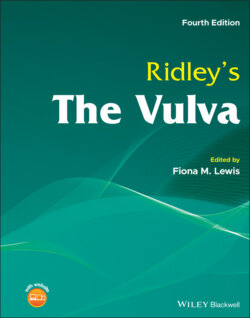Читать книгу Ridley's The Vulva - Группа авторов - Страница 25
Carnegie stages 15 and 16
ОглавлениеThe indifferent gonad begins to develop (day 35) on the medial aspect of the mesonephros by the invasion of three other cell types: the primordial germ cells, cells from the overlying coelomic epithelium, and the cells from the adjacent mesonephros. All cell types are probably essential to the proper differentiation of the gonad. The paramesonephric ducts (Müllerian ducts) appear at about 40 days. The precursor of each duct extends caudally as a solid rod of cells in the intermediate mesoderm, in close association with, and initially lateral to, the mesonephric (Wolffian) duct. The mesonephric duct has been shown experimentally both to induce the paramesonephric duct [11] and to guide its descent [12]. The growing caudal tip of the paramesonephric duct lies within the basement membrane of the mesonephric duct. As they descend, the paramesonephric ducts pass ventral to the mesonephric ducts and, coming into close association with one another, reach the posterior aspect of the urogenital sinus within the urorectal septum (Figure 1.9). The two paramesonephric ducts begin to fuse even before their growing ends reach the urogenital sinus [13]. As the urorectal septum reaches the cloacal membrane (day 30–32), the caudal end of the mesonephric duct, having already opened into the urogenital sinus, begins to form the ureteric bud and be incorporated into the posterior wall of the urogenital sinus. The portion of each duct incorporated into the urogenital sinus subsequently forms the trigone of the bladder and the posterior wall of the urethra (Figure 1.10a–d). At 42 days post ovulation, there are 300–1300 primordial germ cells within the indifferent gonads destined to become either spermatogonia or oogonia. The close association between the gonad and adrenal at this early stage of development can result in adrenal cells being sequestered in the gonad and maintaining their function in the mature ovary or testis.
Figure 1.7 (a) The primitive hindgut is enclosed within the embryonic tail fold. (b) The developing urorectal septum grows dorsally and caudally from the rostral limit of the allantoic diverticulum. (c) The fusion of the urorectal septum with the cloacal membrane divides the hindgut into the urogenital sinus and the rectum.
Figure 1.8 (a) The paired primordia of the genital tubercle lie immediately caudal to the umbilical cord. (b) Migration of tissue towards the midline from both sides separates the umbilical cord and cloacal membrane, causing fusion of the primordia to form a midline genital tubercle and establishing bilateral cloacal folds and genital swellings. (c) Fusion of the urorectal septum with the cloacal membrane separates the anterior genital region from the posterior anal region.
Figure 1.9 The indifferent human embryo possesses mesonephric and paramesonephric ducts. The terminal paramesonephric ducts fuse within the urorectal septum and reach the urogenital sinus at the sinus tubercle situated between the openings of the two mesonephric ducts.
Figure 1.10 (a) The mesonephric duct, within the urorectal septum, opens into the urogenital sinus. (b) The caudal limit of the mesonephric duct gives origin to the ureteric bud. (c) The metanephric cap forms at the growing end of the ureteric bud or duct. (d) The mesonephric duct gives origin to the ureter and forms the trigone of the bladder and the posterior wall of the urethra.
